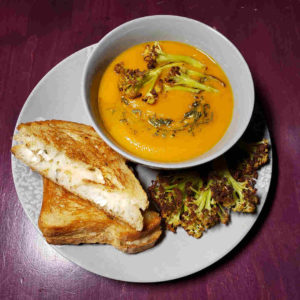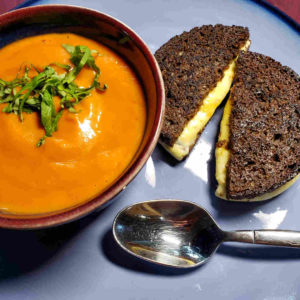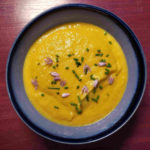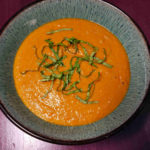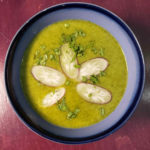The Elements
The Star Ingredient
Campbell’s made several star ingredients famous with their condensed soups; cream of mushroom, cream of broccoli, cream of celery… Make cream soups with market fresh ingredients, and I guarantee you’ll appreciate them so much more. So many options exist: asparagus, broccoli, butternut squash, zucchini, corn, kohlrabi, sweet potatoes. Even greens like spinach, kale and collards can be the star of a cream soup. Often, when making a cream of soup with greens, some potatoes are included to augment the body of the soup.
Besides deciding on the star ingredient, you also have to decide how it is cooked. The simplest option is to have the vegetable poach directly in the cooking pot. But, if you want to capture some nice caramelized notes, you can roast or pan sear the star vegetable before they get thrown into the pot. Mushrooms, winter squash, and sweet potatoes are all options that work well with a bit of browning.
The Aromatics
When in doubt, a medium yellow onion and a few cloves of garlic work nicely as the aromatics. For a softer flavor, leeks or shallots can replace the onion. Green garlic, when in season, is nice. A full mirepoix/soffritto (onions, carrots and celery) may be used for a more complex flavor.
And, like the star ingredient, you must decide whether to simply sweat the aromatics, or if you want them to get a little bit of color. Brown is flavor, so getting some color on those aromatics will certainly increase the flavor of the final soup. But, the browning can overwhelm and distract from star ingredients which have a finer flavor. Generally, if you opt to brown the star ingredient itself, then you may want to also brown the aromatics.
The Cooking Fat
My two go-to options are butter and olive oil. Butter works best when you want some caramelization flavor when cooking the aromatics; say for a cream of mushroom or cream of butternut squash soup. Olive oil works best when you want a cleaner flavor where you just want to softening the aromatics; say for cream of asparagus or cream of zucchini soup. Using coconut oil can bring ethnic influences to the dish. If you are considering using bacon lardons to garnish the soup, you can cook them up first and then use the rendered bacon fat as the cooking fat for the aromatics.
How much cooking fat do you need? If you want to break out the measuring devices, a tablespoon of cooking fat per pound of aromatics is about right. But I usually use my eyes as a guide. You want to use enough cooking fat so that the chopped aromatics uniformly glisten, without there being so much fat that it pools at the base of the pan.
Stock
Normally, you don’t want the stock to have a strong presence in a cream of anything soup. A nice neutral chicken or vegetable stock is the best choice. Water is even acceptable.
Herbs, Spices, and Other Flavorings
Often salt and pepper are the only seasonings I add to a cream of anything soup. The aromatics bring enough complexity to let the star ingredient shine. But, including other herbs such as thyme, oregano, parsley or bay leaves are classic touches. The options are endless. For a Thai flair, use coconut milk and add fresh ginger and red curry paste. For a Caribbean flair, use coconut milk and add some spicy pepper and jerk seasoning. For a North African flair, add some cumin, coriander and harissa paste. Garnishing cream of anything soup can also add some little bursts of contrasting flavors with the homogeneous flavor of the soup.
The Cream
Cream isn’t necessary in a cream of anything soup. Simply pureeing everything at the end of the cooking process produces a smooth, richly textured soup. I usually reserve judgement on the addition of cream until the puree is almost complete and I give a final taste test for seasoning. Admittedly, though, I usually add an ounce or two of heavy cream. I do this for the mouthfeel. I find that it takes the dish from nice to luxurious. But, if you want a vegan soup, you can skip the cream, or use almond or coconut milk. Coconut milk is a nice option if you want a Caribbean, Indian or Thai flair to the soup. Oh, and the tartness of buttermilk can be a fun option.
Other Finishers
Besides cream, other finishing touches can be added at the end of the cooking process. Tasting is the key to determining what, if anything else you want to do to the soup. First, taste for salt. You should be salting as you go, but conservatively because you can’t remove salt at the end. Besides salt, consider brightness and umami. I often end with a splash of Worcestershire and Texas Pete. Both are vinegar based, and the acidic vinegar brings brightness. The pepper in Texas Pete enlivens the taste buds and the Worcestershire brings umami and complexity. Just a teaspoon of each is plenty. Optimally they lift the dish without being individually detectable.
Garnishes
A good cream of anything soup should be good on its own. But, some simple garnishes can take it over the top. You’re looking for three things when you garnish your soup. 1) Visual appeal. You take your first bite with your eyes, and cream of anything soup is easy to dress up. 2) Flavor. You want flavors that complement the something in the soup and provide diversity in every spoonful. 3) Texture. A little crunch is the main option, but a little chew can also be interesting. Multiple garnishes are often better than a single garnish. The options are truly limitless, but here are some ideas:
- More of the anything: Whatever the star ingredient is. Use it as a garnish. I reserve some of the best-looking pieces of browned mushrooms to top my Cream of Mushroom Soup. I thinly slice raw radish to top my Cream of Radish Greens Soup. For broccoli and cauliflower, I like to cut up some tiny florets and roast them until they are brown and crispy, and use them to garnish my Cream of Broccoli Soup or Cream of Cauliflower Soup.
- Another thing: You know how well different roasted vegetables go together. The same can apply to a roasted vegetable and a cream of anything soup. Like garnishing roasted butternut squash soup with roasted cauliflower or roasted mushrooms on roasted cauliflower soup.
- Croutons: Not the totally dried up and probably stale things from a bag in the back of your pantry. A piece of dry toast and chopped up into bite sized pieces is better than that (and, honestly, something I use often enough). But the best is to make real croutons yourself. Cube up some hearty bread. Sauté some smashed garlic in a tablespoon of olive oil. Remove the garlic and add the bread and stir vigorously to coat all sides of the cubes with olive oil. Continue to sauté, stirring occasionally, until the croutons are browned and crunchy on the outside with soft centers.
- Nuts: Nuts are a great way to bring some crunch to the party. My two favorites, because I think their flavors work well with many cream of anything soups and I generally have them in my pantry are roasted pistachios and roasted sunflower seeds. Chopped hazelnuts are another unique option and toasted pine nuts are classic.
- Fresh Herbs: It’s a no-brainer to chiffonade some basil to top Cream of Tomato Soup. Chives go with almost any cream of anything. If you have chives in the garden, their flowers are edible and really pretty. See my Cream of Kohlrabi soup for a photo. Depending on the anything, fresh parsley, cilantro, mint, or tarragon can all be really nice.
- Flavorful oils: Some oils pack their own flavor, such as pistachio or walnut oil or a really good olive oil. You can also make a quick infusion by sautéing an herb or garlic in oil and drizzling that over the top. My favorite herb for this is rosemary. The rosemary flavor gets infused throughout the oil, and the rosemary needles crisp up and add some texture to the soup.
- Dairy: Drizzling a teaspoon of cream in a spiral around the top of the soup is quite pretty. Adding a dab of sour cream, crème fraiche or plain yogurt offers a nice tart contrast to the natural sweetness of many cream of anything soups.
- Cheese: Yeah, I guess it’s dairy, but seems like a separate option. Grated Parmesan goes with almost any cream of anything soup. So does chèvre. Sharp cheddar and broccoli pair wonderfully.
- Spicy Red Sauces: Think sriracha, sambal oelek or harissa. The color is awesome, and they are flavor bombs.
- Everything’s Better With Bacon: It’s almost a sin to add meat to a vegetarian (vegan if you omit the heavy cream) cream of anything soup, but there’s no denying how well crispy bacon lardons work as a garnish. Another alternative is to crisp up some prosciutto. Lay a slice of prosciutto on a baking sheet and put in an oven at 375°F for 10 minutes, flipping halfway through. The prosciutto should be completely crispy and easy to crumble over the top of the soup.
The Method:
Basically, you are going to sauté the aromatics, add the star ingredient (either raw or roasted), cover with broth, simmer until everything is cooked, puree everything into a homogeneous blend, taste and adjust seasoning, then serve. There you go, a one sentence recipe. The exact ratio of liquid to vegetable will vary with how much liquid the vegetable will give off while cooking. Tomatoes are an extreme example as they release a tremendous amount of liquid. I like to start with less liquid than I think I’ll need. You can always add more liquid later, but you can’t remove liquid once you’ve put it in the soup!
How to Puree
When it comes time to puree the soup, as I described, I’m a fan of an immersion blender. It is fast and it is easy to clean up. But it doesn’t make as smooth of a puree as a traditional blender.
If you want the smoothest puree, then go for a traditional blender but be careful. If you fill a blender with hot soup and kick it into high gear, the air in that vortex can heat up and expand explosively. Literally. If you go the blender route, work in batches, only filling the blender half way. Hold the top in place with your hand and a dish towel for protection, and start the blender on low and slowly bring the speed up. As you blend in batches, you have to move the finished batches to a second pot. So, not only do you have this blender to clean up, you also have to clean up an extra pot. For the truly smoothest puree, you can pass the blended soup through a fine mesh strainer. But, there’s another thing to clean up.
It may be that the ease of the immersion blender is my true motivation, but I’m also convinced that the smoothest puree is not the ideal puree. I enjoy the rustic character of a soup with an immersion blender puree.
Make It a Meal
Cream of anything soup makes a great appetizer. I used to look for cream of butternut squash soup on restaurant appetizer menus. That was before I realized how easy it is to make. So, if you are making a special dinner, and multiple courses are in order, go ahead and make cream of anything soup as an appetizer. But, for a weekday meal, I don’t want to put much more effort into the meal. That’s where grilled cheese comes in to play. Grilled cheese is the optimum pairing for cream of anything soup. Pure comfort. Soup, sandwich and a salad also sounds nice. But, often when I am in the mood for cream of anything soup, I’m in the mood for comfort. Grilled cheese is comfort. Salad is less so. I don’t have to feel guilty about not having my vegetables without that salad. There are plenty in the cream of anything soup.

Cream of Anything Soup
Equipment
- Stock Pot
- Immersion Blender
Ingredients
- 2 tablespoons cooking fat
- 1 medium yellow onion, 6-8 oz diced
- cloves garlic minced
- 1.5 lbs fresh vegetables roughly chopped
- 4 cups vegetable or chicken stock, approximately
- 1-2 oz heavy cream optional
- Salt, pepper, herbs and spices, to taste
Instructions
- Sauté the onions or other aromatics in the cooking fat and ½ tsp of salt until they are at their desired state (just softened, or slightly caramelized, depending on the flavor profile you desire), stirring in the garlic for the final minute or two.
- Add the fresh vegetables to the pot and add enough stock to just reach the top of the other ingredients. Turn the heat to high and bring to a boil. Lower the heat to low, cover the pot, and simmer.
- After about 10 minutes, check on the status of the pot. If there is excess liquid due to water released from the fresh vegetables, let the simmering continue without the cover. If most of the ingredients are above the stock line, add more stock. Once the liquid level looks right, cover and continue simmering.
- Continue to check every 10 minutes. Adjust the liquid levels and check for doneness. The star ingredient should be soft and tender. Spinach or zucchini may be done in 20 minutes, where butternut squash or turnips may take 50 minutes.
- Once the ingredients are fully cooked, use an immersion blender to puree everything into a smooth soup. Final adjustments are made at this time. If the soup seems too thick, add stock or water. Taste for seasoning and creaminess. For a richer mouthfeel, add cream at this point. Add salt and pepper to taste. To brighten the soup, add a teaspoon or two of apple cider vinegar.


